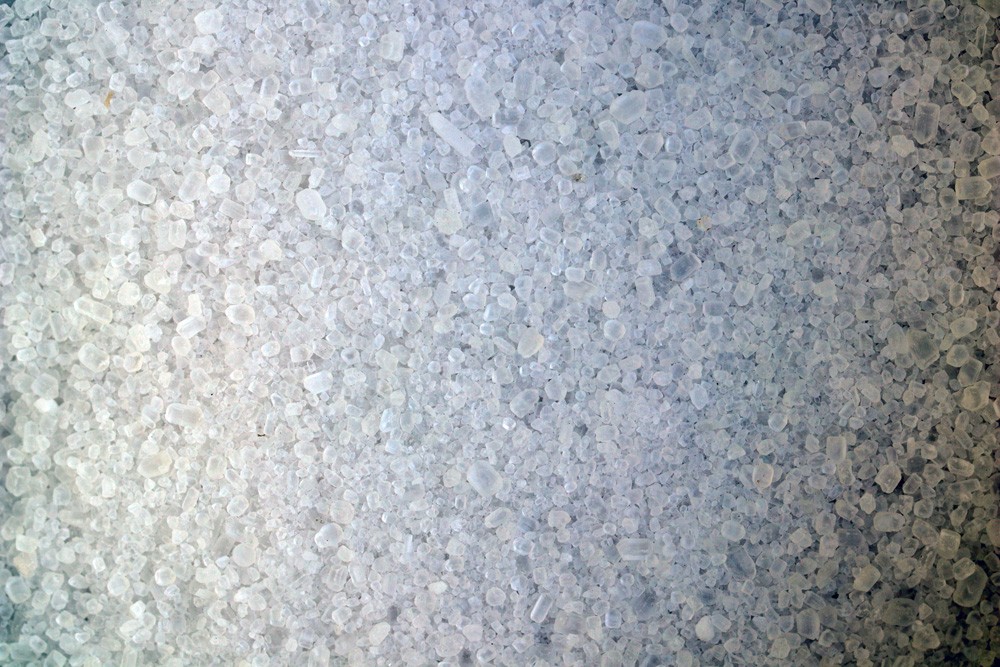Epsom salt is used in a wide variety of areas, as it is recommended again and again in the cosmetics industry and in health care. But also hobby gardeners appreciate the benefits of Epsom salt, because it is a time-tested fertilizer. Find out if Epsom salt is suitable for fertilizing tomatoes here!
Contents
What is Epsom salt?
Epsom salt is also known as “magnesium sulfate” and is mostly offered in solid form. In pharmacies, it is mostly offered as a white, crystalline powder or in the form of shiny colorless crystals. Magnesium sulfate contains – as the name suggests – both magnesium and sulfate. These two nutrients are essential for many plants, which is why fertilization with Epsom salt is often recommended.
- colorless
- odorless
- water soluble
contains about 16 % magnesium and 13 % sulfur
Note: Magnesium sulfate is often a component of complete fertilizers, also called compound fertilizers.
Magnesium
Especially the high magnesium content of Epsom salt benefits the plants. After all, magnesium is essential for photosynthesis and a central building block of chlorophyll. Magnesium is involved in the formation of sugars, from which plants in turn produce cellulose and other endogenous substances. Magnesium is usually found in sufficient quantities in the soil, whereby the values should be approximately as follows:
- light soils (sand or loamy sand): 3 – 4 mg per 100 g
- medium soils (sandy to very sandy loam): 4 – 6 mg per 100 g
- heavy soils (loam or clayey loam): 6 – 9 mg per 100 g
Magnesium deficiency
Especially in particularly sandy soils, magnesium may simply be washed out of the soil by precipitation. In this case, an annual loss of about three grams per square meter is assumed. In loamy soils, the loss is usually less, as the magnesium can attach itself to the clay minerals contained in the soil. Whether the plants are receiving too little magnesium becomes apparent relatively quickly. This is because a magnesium deficiency means that not enough chlorophyll can be produced, resulting in the following symptoms:
- Tomatoes become stunted (length growth)
- they really shoot up
- leaves turn yellow
- later the foliage turns brown
Epsom salt for acute magnesium deficiency

If magnesium deficiency is suspected, tomatoes can be quickly and easily fertilized with Epsom salt. Since Epsom salt is highly soluble in water, it is a good idea to use it in liquid form in a one-percent Epsom salt solution. For this purpose, about 10 grams of Epsom salt are mixed with one liter of water and then sprayed directly onto the leaves. The advantage here is that the leaves absorb the nutrients directly and the fertilization thus takes effect particularly quickly. But be careful: when fertilizing with Epsom salt, the following should be observed:
- Do not spray tomatoes in the blazing midday sun!
- Parts of the plant could burn
- spray with water after spraying
- even better is to apply spray solution after precipitation
Note: The mixture should always be chosen carefully, as overfertilization with magnesium can cause potassium deficiency.
Fertilizing with Epsom salt
Many amateur gardeners apply Epsom salt to fertilize a wide variety of plants in the garden. For this purpose, the Epsom salt is usually distributed in the garden in the form of granules. However, this is not necessarily recommended, as not all plants have a high magnesium requirement. However, there are guideline values for fertilizing with Epsom salt that hobby gardeners can follow:
Light and medium soils
- fertilize 2 – 3 times per season
- about 30 g per m²
- heavy soils
- fertilize once per season
- about 30 g per m²
Soil analysis
The guideline values are ultimately only a guide, but should always be used with caution. If you want to optimally adjust the fertilization to the soil, you should definitely have a soil analysis carried out before using Epsom salt. This involves taking several samples from the soil and then passing them on to experts for analysis. The soil analysis provides information on the composition of the soil as well as guidance on the form in which fertilizer should be applied. To perform a soil analysis, one needs a special analysis set from the specialized trade. Then amateur gardeners proceed as follows:
- take soil samples at different places
- in total about 15 – 20 samples
- Record detailed information on the location of the sample in the data entry form.
- send the container together with the data collection sheet to the laboratory
- the samples are analyzed in the laboratory
Note: A soil analysis costs about 50 euros and is valid for about five years. For this reason, it is advisable to make a soil analysis every five years.
Epsom salt as a sulfur fertilizer
Epsom salt is primarily characterized by its high magnesium content. However, magnesium sulfate also contains sulfur, another important nutrient for plants. Sulfur deficiency is relatively rare nowadays, especially if the soil is regularly enriched with compost or rotted cattle manure. However, it can still happen that tomatoes receive too little sulfur. In this case, Epsom salt may well be used as a sulfur fertilizer A sulfur deficiency can be identified in tomatoes as follows:
- resembles nitrogen deficiency
- leaves and leaf veins turn yellow
- usually only young leaves affected

